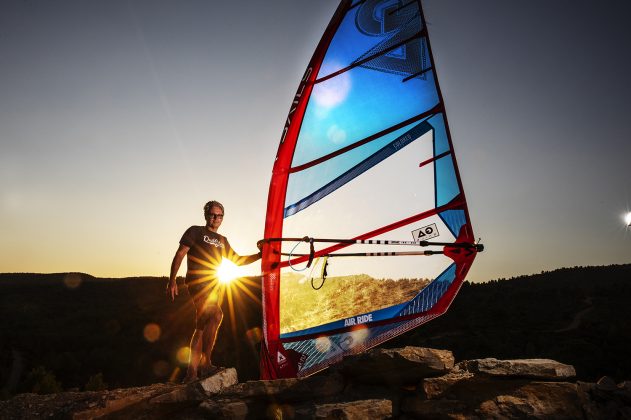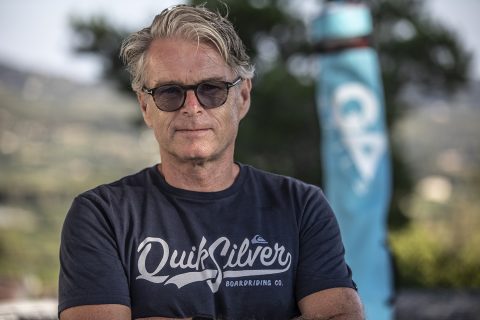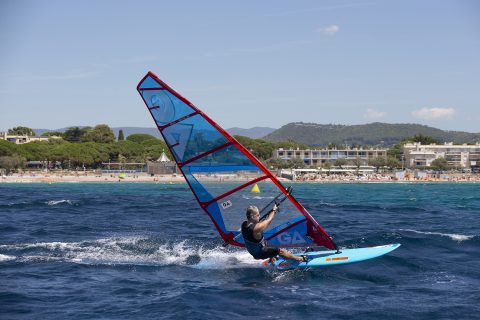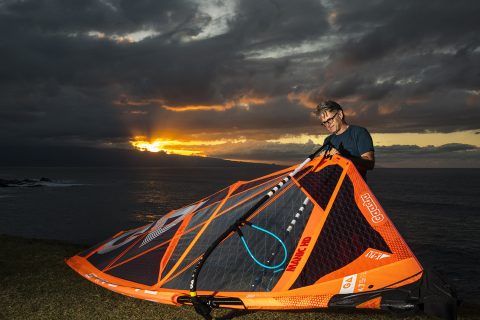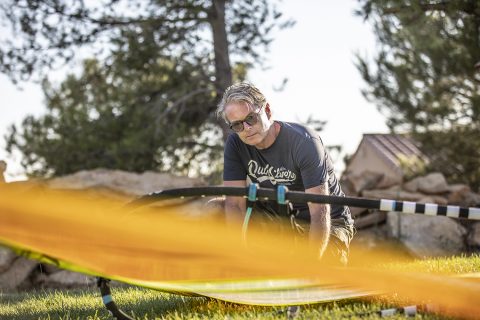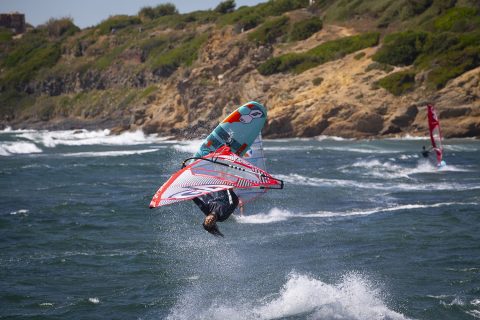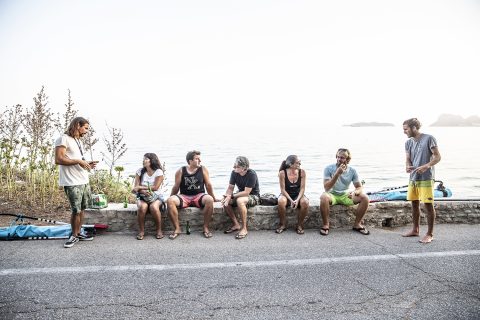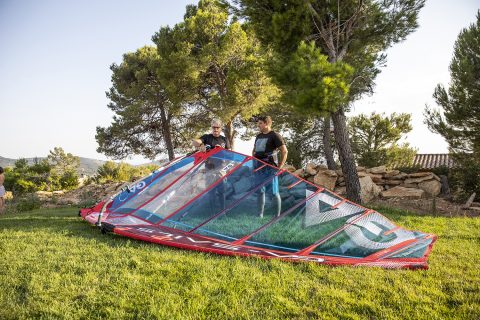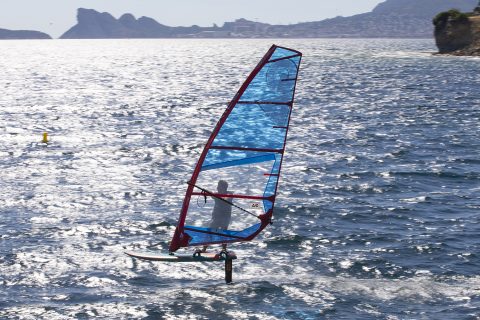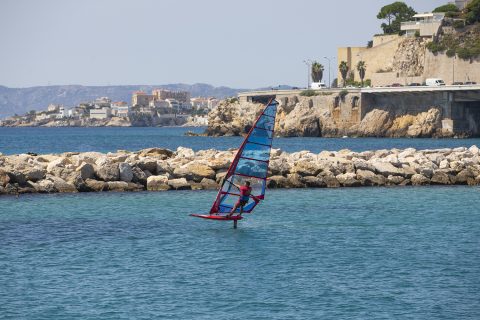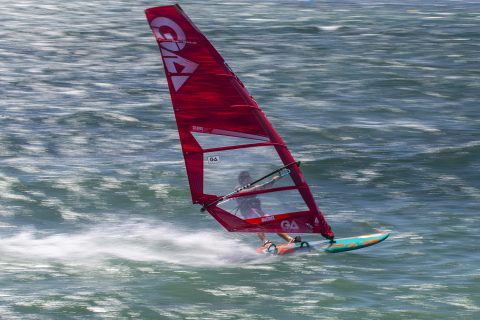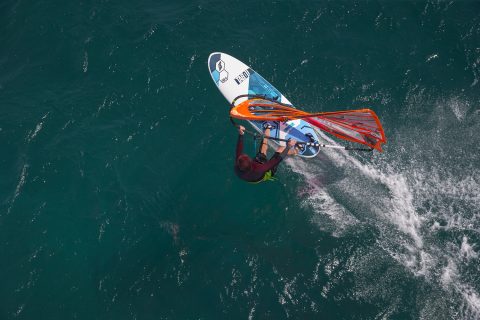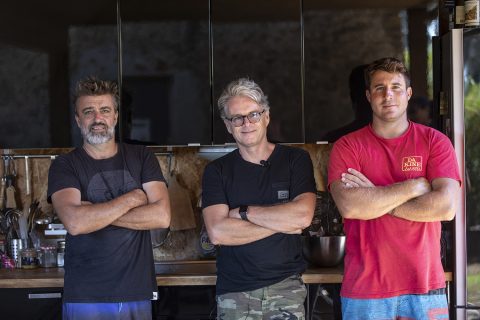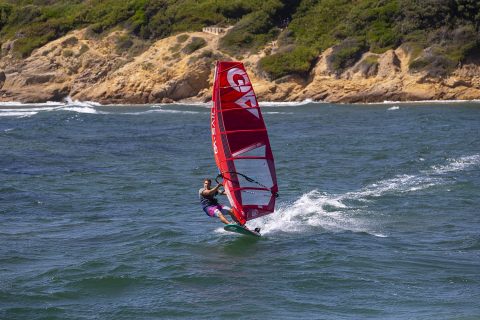From our October 2020 issue of Windsurf Magazine we caught up with Peter Munzlinger who is the man behind the designs at GA Sails. He tells us about his work, the new requirements that foiling brings, and how he got started in the windsurfing industry.
Words Peter Munzlinger // Photos John Carter.
To read more features like this first, Print and Digital subscriptions are available. Prices include delivery globally for 10 x issues a year!
- Click to enlarge: Peter Munzlinger
BACKGROUND
I was a passionate windsurfer from the age of 16 back in the 1980s. While most of the guys I sailed with were interested in building their own boards, I was into making and adjusting my own sails. This part of windsurfing fascinated me. I remember the first thing I did when funboard equipment first arrived on the scene was to take some Division 2 sails and modify them with a shorter boom to make them into funboard sails. I had seen pictures of guys in Hawaii and was inspired to make the changes so I could have similar equipment. Before windsurfing I was also into sailing, my parents had a sailing boat and I had a catamaran. Somehow I was attracted more by the sails in windsurfing than the boards.
- Peter in action in France!
LAKE GARDA
After school I went to university to study engineering, but my first job was in Lake Garda. I grew up in Tuscany in Italy on the coast, and after the summer holidays I had an opportunity to go to Lake Garda to work in a windsurfing shop. It helped that I knew how to speak Italian and German perfectly. I took the job and that is where I met the guys who were doing the North Sails distribution for Italy. They noticed my passion for sails and luckily they offered me a job. After that I made the decision to move to Lake Garda, which at the time was one of the big centres of windsurfing in the world. In Tuscany I would never have had any opportunities; I had to move. With North Sails, I worked hard and started doing sail repairs, which was the real beginning of my sail design career. Within a few years I made some sails for myself and at the distributor meeting for North Sails in Garda, the guys tried my designs and they were performing better than some of the North Sails at the meeting. After this I was invited to start designing one simple sail in the range, that is how it all started.
After North sails, I had a spell where I worked for Dakine who wanted to make windsurfing sails, then I had a spell with Yes Sails who were in Lake Garda and were quite successful as a small brand. I sponsored Andrea Cucchi back then and we were also great friends. When he decided he wanted to start his business with Point-7, he called me and then I worked with him for many years on the ‘Black Sails’! We were very successful with racing with the late Alberto Menegatti and won many races at European and world level; it was a cool period working with Andrea.
- On duty in Maui.
GAASTRA
One day Knut Budig from Gaastra called me and offered me the chance to be their designer. It didn’t take me long to make the decision to take the job as this was a very good opportunity for me to work with a bigger established brand. This was the end of 2010. I started with Gaastra and I am still here ten years later. My first job was to work on The Vapor race sail as it was at the end of the season and it was not finalised. Basically I started from zero and didn’t have the Gaastra design software at the time, so made the sails my way. Arnon Dagan and Alberto came to my place in Sardinia where I had moved to and we worked non-stop on the prototypes. We were lucky because we had a month of wind every day. It somehow all came together, even though it was a lot of hard work. After this initial period I started using the Gaastra software and getting to work on the rest of the range over the following years. After the first season I could gradually start introducing my own ideas into the designs. When a company makes over one hundred sails in the range in all the sizes, it is not like you can make changes overnight.
In the past two years foil windsurfing has exploded into the market. For this project it meant completely new designs; something I was very excited about and it has been a real passion project producing the GA foil sail.
- Keeping an eye on his designs
GOALS
I still windsurf a lot myself, so one goal for sure is to meet the intended purpose of the sail and the needs of the customer who are going to buy it and their expectations. As I am a sailor myself, what I am looking for is a sail that is easy and user friendly. I don’t want to have sails that I am fighting with, but at the same time I also want a good performance. You have to find a compromise between power to get planing early, the range of use and how comfortable it is. Some ranges I can test myself or use guys where I live, but with the race and wave ranges I need the input from the pro riders. Our team is vital here for their feedback. For the development of the Vapor I work in close contact with Cedric Bordes and Ross Williams, I have to filter the information and try to understand and translate it into my reality of what is possible. For the wave sails I work mostly with Ross Williams and Thomas Traversa. Lately for the foil specific Vapor Air I worked closely with Sebastian Kordel and Nico Goyard who are among the best foil racers in the world.
It is great to work with such a talented team, those guys are such awesome sailors and give me precious feedback.
- Sails in action in France!
MOTIVATION
I still love windsurfing. Every time it is windy I want to go sailing and that usually involves testing. After all these years the fact I have to test my sails is a good motivation. If the conditions are not that great but I have some new prototypes, I can still get excited about going sailing. I want to see as soon as possible how they perform. The foil explosion was a huge motivation for me. I was very interested as everything was totally new and exciting. It was a challenge, making new sails for a new concept and trying to work out how everything works.
- Hanging with the team in France
THE OTHERS
With the Internet we can always see what the other brands are doing with their designs. I am always interested to see what is happening with other designers. Sometimes I have ideas before others, but then I see they have had the same concept. Anything new is interesting to me. All the designers are doing a great job. There is a mutual respect between all the brands and a lot of fantastic designs on the market.
BEST AND WORST
The best part of the job is that I can go windsurfing as part of my duties when I am testing. Being on Maui at the GA photo shoots are like a dream come true for me. On the other side there is a lot of stress with deadlines and making sure all the ranges are ready. I have to travel to China several times a year to make sure everything is ok with the production process. It looks like a dream life and job, but at the end of the day there is still a lot of hard work to do.
- Checking out the new sails
RIGGING ERRORS!
Definitely the most common errors are not enough downhaul and way too much outhaul! That is a great classic. That way you get a super tensioned leech and a loose luff, the opposite of what is desired. You want a nice tensioned leading edge of the sail and a free twisting leech to get performance and stability. So downhaul to the specs. to get a nice and loose head, then start at the outhaul with a neutral tension, if it’s windy and you are overpowered you add 1 or 2 cm more, if it’s light and you need power, release 1 or 2 cm. Another issue is the boom height. Standing on the board it should be around chin height, and again if you are overpowered and need control, lower it a few cm, and do the opposite in light winds and if you need power.
RESULTS
With Gaastra we have won a wave title with Thomas Traversa and we have won and been on the podium at many PWA events. This is very satisfying for me to see these results. We were also very successful with foil racing results. What we are missing is the PWA slalom overall title, but that is very difficult to achieve. At the moment Albeau, Iachino and Mortefon are dominating, so it pretty difficult for any other riders to challenge these guys.
- Foil action
FOIL SAILS
Foiling requirements are very different than normal windsurfing, you completely eliminate all the chop and impact situations, so you can concentrate more on the performance and aerodynamic aspects. The outlines are different as you sail more upright, so to close the gap on the board you need a lower foot outline. Then you need less back hand pressure as the power comes mainly from the foil and you want easy control, so in general I design a shorter boom and something stiffer and more stable in the sail (not too stiff as you still need some flexibility to pump onto a plane in super light winds). For the aerodynamics a higher aspect design (longer and more narrow) help too, it does not work so good for traditional windsurfing as it puts you more out of balance, but for foiling it makes you faster and pointing higher. On foiling race sails in particular you also have a flatter entry profile for more performance, on a normal windsurfing sail you would not like that too much as it is more critical to sail and less forgiving in chop.
- Foil action in France
NEW IDEAS
What is interesting when you try something new in a sail line is that this concept can suddenly adapt to other sails in other ranges. With the foil sails I experimented a lot and it brought quite a few new ideas which I could use in our slalom sails. Slalom sails must be able to handle chop and the rig must be flexible to spill the excess power out. On a foil sail you are out of the water and the sail is very stable and smooth. The rig does not move at all because you have no impact. However some features can work for both types of sail. On the foil sails the emphasis was about the control and less back hand, so during the development progress I put in more and more concepts to improve this. Other performance and aerodynamic oriented features of the foil sails were not really applicable, but I took over some shaping ideas and the way I structure the panels to the other sails when I was looking for increasing the control and overpowered handling. In particular using negative shaping and the positioning of it.
- Full speed in France
TRENDS
Theoretically we could have a lot of new technologies to build superior sails, but the main factor limiting this is the cost. A windsurf sail cannot cost 3000 euros! Nobody would buy it. If you look at the America’s Cup, they have unlimited budget and those sails cost tens of thousands. You cannot compare it. I would say construction is the area where big changes could be made! We are still using the old method of sewing the panels together in an ancient way. It depends on the cost efficiency, but it will come for sure. Potentially we could be sticking the panels together (glue) or even moulding them in one piece. Theoretically for the performance of the sail we could become super light with the modern materials, but on the other hand if they are getting too thin we will have big issues with chafing and durability. The trend in the past years, which I think will continue into the future, is more performance, but at the same time having sails that are easier to use with a bigger range. That is the main goal. In the past you had a very narrow range of use with a sail, but now you don’t need that much equipment to go sailing. If you don’t have specific needs as a super specialized sailor, I would say one square metre between sizes is fine for recreational sailing in light winds. For wave sailing or stronger winds you need a smaller spacing, as when the wind gets stronger the forces increase exponentially.
- Birds eye view
SIZE MATTERS
Basically the only difference between big and small sailors is the size they choose for a given condition. I have sailed a lot with bigger guys than me (75 kg) like PWA slalom sailors, who are mostly 90 kg +, and I was just using their smaller stuff. I didn’t have to change the settings except boom height (as they are also taller than me) and for the same reason shortening a little the harness lines.
SAIL SOFTWARE
I use specific software for sail design. It is not about simulation or 3D stuff, but more about efficient designing. It is parametric and I can easily change one or more parameters and then push a button and the software generates the panels. As I have to design more than 100 sails each season that’s the only way to make it possible. As an example, if you would design a sail by hand, and only change one aspect, let us say boom length for example, you would have to redesign the whole sail.
- Hanging with the team
SAIL CARE
First and most important thing is keep the sail out of the sun as much as possible, so when not sailing, try to put it in the shade. The UV rays of the sun literally destroy the materials the sail is made of and shorten dramatically the life span of a sail. At Gaastra we try to minimize that using UV inhibitors in our laminates and also the metallic flakes in our X-Ply help reflect the harmful rays, but still you have to take care of that. The materials the sails are made of have no problem with salt water, but if you rinse your sail frequently with fresh water you wash the salt crystals and the dirt away, which over time scratch the monofilm and reduce the visibility of the sail window. Also avoid sharp objects, rigging on rocks and creasing your sails, these things are more common sense, just take care!
- Cedric Bordes in action
AMBITION
My ambition is to try and make the most successful sails on the market and one day win the PWA slalom title with our sails. Now with foiling we have a great chance for success, we are already on the podium and I am confident we can have great results.

